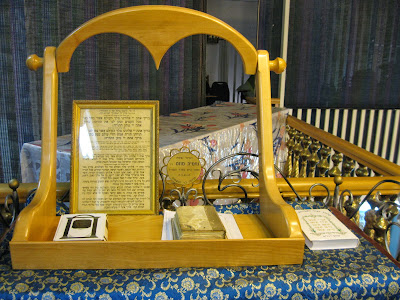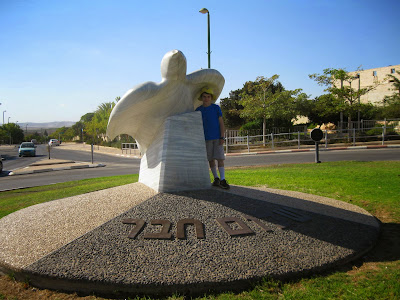.
Two van-loads of Meitar folks drove through a desert sandstorm this morning to reach this place in the Negev.
What's under the big top?
A circus??
No!
Something better--a lunch prepared by the women of Nevatim!
Nice chicken, rice, salads.
Thankfully, not with TOO much Indian spices.
Tapioca pudding-type dessert with silvery pearl tapioca "beads."
In
the framework of the Agriculture and Tourism Ministries' 'Village 2000'
program, Nevatim was recognized as a 'Tourism-oriented Village' with
the aim of developing tourism as an alternative to the declining economy
of family farms. - See more at:
http://www.ica-is.org.il/en/projects/bnei-shimon-regional-council#sthash.Eka8Df1G.dpuf
These two women are part of the Cochin Jewish community who started to leave Kerala in the early 1950s and immigrate to the young state of Israel.
Lunch was served after we had a fascinating lecture and video about the Jews of India, a guided tour of the Cochin Jewish Heritage Center, and a visit to the moshav's beautiful synagogue built in the Kerala style.
I'll try to post
those photos over the coming days (grandchildren permitting).
.
(Linking to
Whimsical Windows, Delirious Doors and to
Our World Tuesday.)
.
In
the framework of the Agriculture and Tourism Ministries' 'Village 2000'
program, Nevatim was recognized as a 'Tourism-oriented Village' with
the aim of developing tourism as an alternative to the declining economy
of family farms. - See more at:
http://www.ica-is.org.il/en/projects/bnei-shimon-regional-council#sthash.Eka8Df1G.dpuf
In
the framework of the Agriculture and Tourism Ministries' 'Village 2000'
program, Nevatim was recognized as a 'Tourism-oriented Village' with
the aim of developing tourism as an alternative to the declining economy
of family farms. - See more at:
http://www.ica-is.org.il/en/projects/bnei-shimon-regional-council#sthash.Eka8Df1G.dpuf
In
the framework of the Agriculture and Tourism Ministries' 'Village 2000'
program, Nevatim was recognized as a 'Tourism-oriented Village' with
the aim of developing tourism as an alternative to the declining economy
of family farms. - See more at:
http://www.ica-is.org.il/en/projects/bnei-shimon-regional-council#sthash.Eka8Df1G.dpuf
In
the framework of the Agriculture and Tourism Ministries' 'Village 2000'
program, Nevatim was recognized as a 'Tourism-oriented Village' with
the aim of developing tourism as an alternative to the declining economy
of family farms. - See more at:
http://www.ica-is.org.il/en/projects/bnei-shimon-regional-council#sthash.Eka8Df1G.dpuf
In
the framework of the Agriculture and Tourism Ministries' 'Village 2000'
program, Nevatim was recognized as a 'Tourism-oriented Village' with
the aim of developing tourism as an alternative to the declining economy
of family farms. - See more at:
http://www.ica-is.org.il/en/projects/bnei-shimon-regional-council#sthash.Eka8Df1G.dpuf





















































